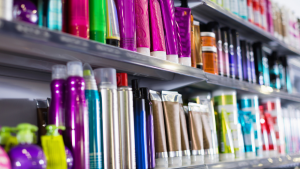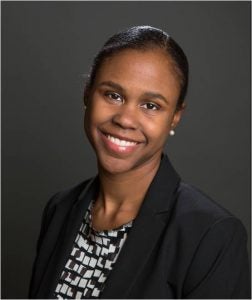
Chemicals in hair products, making rent as a grad student, and more: A conversation with Dr. Tamarra James-Todd
Dr. Tamarra James-Todd’s interest in human health dates back to her childhood, when she would go into work with her mom, who was a microbiologist, on the odd weekend at the Kansas City VA Hospital. Now an epidemiologist at the Harvard Chan School of Public Health, Dr. James-Todd has focused her career on understanding the impacts of toxic chemicals on women’s reproductive and long-term health in order to improve overall health.

Through her research, she has found that 50% of hair care products marketed to Black women contain hormone disrupting chemicals, compared to only 7% advertised to white women based on product label information. Further, the use of these products, such as hair oils and chemical straighteners, can put girls and women at higher risk of health impacts including earlier age at puberty—a risk factor for breast cancer. In addition to assessing racial and ethnic differences in chemical exposure, Dr. James-Todd’s research also includes identifying how pregnancy and complications that occur during this period can impact a woman’s risk of developing diabetes and cardiovascular disease.
I recently chatted with Dr. James-Todd about her work, how she got into the women’s environmental reproductive health field, and how COVID-19 has impacted her many research initiatives.
This conversation has been edited and condensed for clarity.
Sam Lovell: How did you get into the public health space?
Tamarra James-Todd: My mom is a microbiologist, who worked for over 30 years at the VA hospital in Kansas City, Missouri, and I would sometimes go in with her on weekends. And so, as a kid just sitting in a hospital, I became aware of epidemiology as a field and I became interested in medicine. At first, I thought I wanted to be a doctor, but in school the two disciplines that I found most interesting were sociology and math. Because I was still interested in the human body and health, I wanted to find out how I could marry all those different disciplines.
I ended up enrolling in the international health program at Boston University to do my Masters of Public Health. There, I learned more about the intersectionality of these different disciplines in the field of public health work, and how I could integrate my love of math and sociology through epidemiology.
SL: What made you focus on women’s environmental reproductive health?
TJT: When I landed in Boston, I had no idea how I was going to pay rent. I looked at BU’s jobs website and found two positions that were available. One was in food services, and the other was in a research lab. And so that same day, I called, asked for an interview, got the job, and became a Research Assistant in Tim Lash’s [now the editor of the journal Epidemiology] lab working on breast cancer research. That job exposed me to a lot of things that I still study today.
And then through my coursework, I had an opportunity to learn more about hair products. In my Intro to Environmental Health course, our professor presented an ecologic study of magazines advertised to white women versus Black women. In the 1950s, the products for white women were described as “hormonally rich” and “filled with estrogen.” That died down by the 1970s, but began ramping up in Black magazines. That piqued my interest.
At that same time, I was learning how early onset of puberty and early age of menarche [first period] are risk markers for breast cancer. To layer onto that, we know that Black girls reach puberty and menarche earlier. As a Black woman, the topic of hair and hair products, as well as early puberty were very top of mind and heavily discussed within my community.
With this interest, I applied and was accepted into the epidemiology PhD program at Columbia, where I had the opportunity to found the Greater New York Hair Products Study. From that study and later research, we found that – indeed – use of hair oil was associated with earlier age at menarche.
It was really through merging my lived experience, with my interest and exposure to these questions through my work as a research assistant and in my coursework that led me into the space of women’s environmental reproductive health.
SL: What was the research around environmental health disparities like when you started doing this work?
TJT: When I started this work, the vast majority of studies simply reported differences by race. What would happen is someone reported out a finding, described the difference, and left it at that. That’s an unfortunate scenario, because when people go to interpret it, whether in the scientific world or the lay community, it’s assumed that that difference is attributed to some sort of underlying biological differences.
There was very little appreciation that race itself is a social construct and not a biological one. When I would present my findings, there was little understanding of social and cultural drivers of environmental chemical exposures and how these differences could contribute to health and health disparities.
Only just now, 20 years later, people are starting to think “Oh, maybe we should ask why the disparity exists and not just be making an assumption.”
SL: Is there a particular project you are especially excited about currently?
TJT: One of the projects I’m particularly excited by marries where I started with where I am now. It’s looking at use of personal care products during pregnancy to understand the impact of various exposure patterns on pregnancy health.
We have also newly launched a community engagement project where we are getting the opportunity to work with pregnant women and parents of young children to better understand the unique concerns of those communities. While so much of my work has been community relevant, it’s not necessarily community engagement work, so it’s a great opportunity.
SL: How has COVID-19 impacted your work?
TJT: The original plan for this community engagement project was to have everyone come together in person. We can’t do that now. We’re doing virtual interviews and focus groups and just trying to keep things moving.
When you’re doing community engagement work, you have to meet the community where they are. And they are, like the rest of us, struggling with COVID. So you meet them there. We’re trying to figure out how we can get additional information to the population about COVID. As scientists in general, we’ve not always done a great job of communicating effectively. Part of that is that we’re not given relevant courses in health communication and literacy. We’re taught to give big scientific talks at meetings where everyone else is like us.
So, part of the disconnect we’re seeing across the board on COVID, I believe, is from information being lost in translation. I feel that it’s my responsibility to be a better communicator of our research and study results to ensure the lay community has accessible information about their health and their environment.












